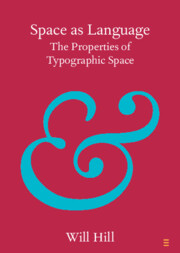Bibliography
Bachelard, G. (1994). The Poetics of Space. Translated by Jolas, M. Boston: Beacon Press.
Banks, C. (2003). Edward Johnston and Letter Spacing. In Berry, J., Randle, J. (eds.), Type and Typography. New York: Mark Batty, pp. 347–353.
Beier, S. (2012). Reading Letters: Designing for Legibility. Amsterdam: Bis.
Boag, A. (1996). Typographic Measurement: A Chronology. In Typography Papers, 1, Reading: Department of Typography and Graphic Communication, University of Reading.
Bollnow, O. F. (2011). Human Space. Translated by Shuttleworth, C. London: Hyphen.
Bringhurst, R. (1997). The Elements of Typographic Style. Vancouver: Hartley and Marks.
Burnhill, P. (2003). Type Spaces: In-house Norms in the Typography of Aldus Manutius. London: Hyphen.
Carter, R., Day, B., Meggs, P. (2006). Typographic Design: Form and Communication. Hoboken: Wiley.
Cinamon, G. (2000). Rudolf Koch: Letterer, Type Designer, Teacher. Delaware: Oak Knoll.
Crystal, D. (1998). ‘Toward a Typographical Linguistics’. Type, 2. 1, pp. 7–23.
Dair, C. (1995). Design with Type. Toronto: University of Toronto Press.
Dowding, G. (1954). Finer Points in the Spacing and Arrangement of Type. London: Wace.
Drucker, J. (2006). Quantum Leap: Beyond Literal Materiality. In Bierut, M., Drenttel, W., Heller, S. (eds.), Looking Closer 5. New York: Allworth, pp. 26–32.
Drucker, J. (1984). Letterpress Language: Typography as a Medium for the Visual Representation of Language. Cambridge: MIT.
Fletcher, A. (2003). The Art of Looking Sideways. London: Phaidon.
Gayford, M., Sylvester, D. (1998). Patrick Heron. London: Tate.
Gill, E. (2013). An Essay on Typography. London: Penguin.
Hendel, R. (1998). On Book Design. Yale: Yale University Press.
Highsmith, C. (2020). Inside Paragraphs: Typographic Fundamentals. New York: Princeton Architectural Press.
Hochuli, J. (2015). Detail in Typography. Montreuil: Éditions B42.
Hoffman, A. (1988). A Graphic Design Manual. London: Academy Editions.
Hollis, R. (2006). Swiss Graphic Design. London: Laurence King.
Hunt, R. (2020). Advanced Typography. London: Bloomsbury.
Hutt, A. (1972). Fournier: The Compleat Typographer. London: Frederick Muller.
de Jong, C. W. (2008). Jan Tschichold: Master Typographer. London: Thames and Hudson.
Kindersley, D. (2001). LOGOS: Letterspacing with a Computer. In Jury, D. (ed.), Typographic Writing. Stroud: ISTD, pp. 174–178.
Kinross, R. (1994). Modern Typography. London: Hyphen.
Kinross, R. (2000). Anthony Froshaug Typography and Texts. London: Hyphen.
Kinross, R. (2002). Unjustified Texts. London: Hyphen.
Krauss, R. (1999). A Voyage on the North Sea: Art in the Age of the Post-modern Condition. London: Thames and Hudson.
Li Er Lao, Tzu. (1997). Tao Te Ching. Translated by Waley, A. and Wilkinson, R. Ware: Wordsworth.
Lissitzky, L. (1999). Topography of Typography. In Beirut, M., Helfand, J., Heller, J. Poynor, R. (eds.), Looking Closer 3. New York: Allworth.
Lommen, M. (2012). The Book of Books. London: Thames and Hudson.
Lupton, E. (2000). Visual Syntax. In Swanson, G. (ed.), Graphic Design and Reading. New York: Allworth.
Lupton, E. and Miller, J. A. (1994). A Natural History of Typography. In Bierut, M., Drenttel, W., Heller, S. and Holland, D. K. (eds.), Looking Closer: Critical Writings on Graphic Design. New York: Allworth.
Martin, D. (1989). An Outline of Book Design. London: Blueprint.
McGann, J. (1993). Black Riders. Princeton: Princeton University Press.
Meynell, F. and Simon, H. (1973). Fleuron Anthology. London: Ernest Benn.
Moholy-Nagy, L. (1999). The New Typography. In Beirut, M., Helfand, J., Heller, J., Poynor, R. (eds.), Looking Closer 3. New York: Allworth, pp. 21–22.
Morison, S. (1996). First Principles of Typography. Leiden: Academic Press Leiden.
Muller-Brockmann, J. (1981). Grid Systems in Graphic Design. Sulgen: Niggli.
Nash, P. (2016). Scaleboard: The Material of Interlinear Spacing before ‘Leading’. Journal of the Printing Historical Society. 25, pp. 71–83.
Nin, A. (1971). The Diary of Anaïs Nin 1939–1944. Vol. 3. Boston: Mariner.
Noordzij, G. (2005). The Stroke: Theory of Writing. Translated by Enneson, P. London: Hyphen.
Papazian, H. (2000). Improving the Tool. In Swanson, G. (ed.), Graphic Design and Reading. New York: Allworth.
Phillips, T. (2005). A Humument. 4th ed. London: Thames and Hudson.
Ronell, A. and Eckersley, R. (1991). The Telephone Book : Technology, Schizophrenia, Electric speech. Lincoln: University of Nebraska Press.
Rosner, C. (1953). Type: Principles and Application. Wisbech: Balding and Mansell.
Saenger, P. (2000). Space between Words: The Origins of Silent Reading. Redwood City: Stanford University Press.
Shaw, P. (2006). W. A. Dwiggins: Jack of all Trades, Master of More Than One. Linotype Matrix. 4.2, pp. 37–47.
Simon, O. (1954). Introduction to Typography. London: Pelican.
Simpson, N. (ed.). (2012) Notes from the Cosmic Typewriter. London: Occasional papers.
Smeijers, F. (2011). Counterpunch. London: Hyphen.
Spencer, H. (1968). The Visible Word. London: Royal College of Art.
Symons, A. J. A. (1973). An Unacknowledged Movement in Fine Printing. In Meynell, F., Simon, H. (eds.), Fleuron Anthology. London: Ernest Benn, pp. 301–325.
Thomas, K. (2015). Rudolf von Larisch: Investigating and Analysing the Ideas and Theories of a Lettering Reformer, unpublished Master’s thesis, Monash University.
Tracy, W. (1986). Letters of Credit. Boston: Godine.
Tschichold, J. (1991). The Form of the Book. London: Lund Humphries.
Tschichold, J. (1998). The New Typography. Translated by McLean, R. London: University of California Press.
Tullett, B. (2014). Typewriter Art: A Modern Anthology. London: Laurence King.
Twyman, M. (1982). The Graphic Presentation of Language. Amsterdam: John Benjamins.
Walker, S. (2001). Typography and Language in Everyday Life. Harlow: Pearson.
Warde, B. (1999). The Crystal Goblet or Printing Should be Invisible. In Bierut, M., Helfand, J., Heller, J., Poynor, R. (eds.), Looking Closer 3. New York: Allworth, pp. 56–59.
Weingart, W. (1973). Elements in a New Context. Retrieved 25 October 2022.



